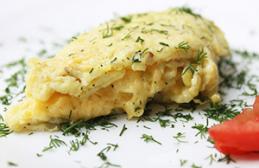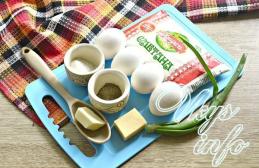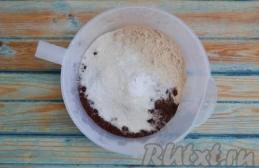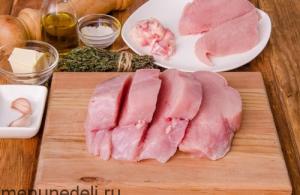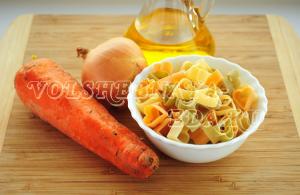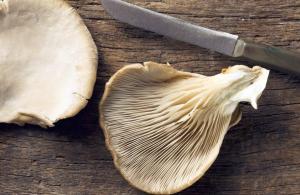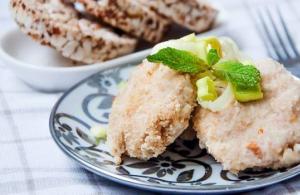Soy milk.
Making soy products at home
In general, soy products are easier to buy. Almost every major city has specialized stores or departments offering a fairly wide range of this type of product. But those who cannot afford this can prepare soy products at home. This is a painstaking task, but not very difficult. The exception is dry textured soy products (various types of soy meat), the production of which requires special technologies. But anyone can prepare milk, okara, tofu, sauce, pasta and even flour. There would only be raw materials - dry soybean grain. And it can be successfully grown in a personal plot. After all, this crop is unpretentious and very productive.
Cooking at home is cooking in a regular apartment kitchen. Having renovated a kitchen of 9 sq.m. (this is the average size of most kitchens) it will be a pleasure to cook various dishes and dine with the whole family. In an ordinary kitchen, you can prepare soy milk according to the recipes we offer.
Soy milk. Homemade recipes.
Option
preparing soy milk 1
.
Soak clean soybeans in cold water for 12-24 hours. Drain the water and grind the beans, passing them through a meat grinder with the finest grate several times. When grinding soybeans, you need to add water little by little to make it easier to grind. Take water in a ratio of 7:1, then you will get milk with 3% fat content (like cow's milk, store-bought). If you take less water, the milk will be fattier, or even cream. Leave the ground soybean porridge mixed with water for 2-4 hours, adding salt on the tip of a knife (to make the proteins disintegrate more easily). After this, put the soy mixture on the fire and keep it at a gentle simmer for 30 minutes. Strain through a linen and squeeze. The milk is ready. And what remains in the linen bag after straining the milk is nothing more than okara - a soy fortifier.
Option
preparing soy milk 2.
Pour a kilogram of dry soybean grain with slightly salted water at room temperature for 16-18 hours so that the water completely covers the grain. Then drain the water and pass the grain through a meat grinder with a very fine grid. Pour the resulting mass with salted water at room temperature (4 l) for 40 minutes and be sure to stir several times with a wooden spoon. Prepare a linen bag, place the soy mixture in it and squeeze over the pan. Pass the mixture from the bag through the meat grinder again, add a new portion of water and repeat the whole cycle again. Mix two portions of the liquid obtained by squeezing the soybean mass and boil, making sure that the milk does not escape.
Option
preparing soy milk 3.
Soak 1 cup of soybeans in 2 cups of water for 12-24 hours. Drain the water. Place soybeans in pre-prepared cold boiled water, place on the stove, bring to a boil and immediately remove from heat. Strain the water into a clean container. Grind the soybeans in a meat grinder, place in a mixer using blades, add half of the strained water and beat until smooth. Then add the remaining water and stir. Squeeze through a double layer of gauze and add salt, honey and vanilla to taste.
Note. To prepare 0.5 liters of milk you will need 400 g of dry soybeans.
Further -
You will need
- For soy milk:
- - 1 cup soybeans;
- - 11 glasses of water;
- - 1/4 cup sugar.
- Kitchenware:
- - blender;
- - large cup (must hold at least 11 glasses of water);
- - several cups;
- - gauze;
- - wooden spatula for stirring;
- - container for storing finished soy milk.
Instructions
Place the soybeans in a deep bowl and add water so that it covers all the beans, leave to soak for 8-11 hours in a warm place. If possible, use mineral, purified water rather than raw tap water, as it can give soy an unpleasant aftertaste.
Add water as needed if it evaporates to keep the beans submerged at all times. Transfer the beans, along with the water in which you soaked them, into a blender, grind, add about four more water, mix to obtain a homogeneous bean paste.
Place the remaining beans (pomace) from the cheesecloth into a blender, add three more glasses of mineral water and blend until smooth. Squeeze the mixture through cheesecloth again, and then return the remaining beans to the blender, pour two glasses of water, stir and strain again.
Boil raw soy milk: pour it into a deep saucepan (so that ¼ of the pan remains free) and place on high heat. Stirring constantly, wait until the mixture boils, carefully make sure that the milk does not stick to the bottom of the pan, remove the foam from the surface (from which it will later become the so-called “Korean asparagus”).
Add a few drops of cold water to the milk, this will help reduce the amount of foam. Reduce heat to simmer and cook for another eight minutes, stirring constantly.
Video on the topic
Sources:
- Soy cooking
Tip 2: What are the benefits of plant-based milk and how to prepare it
Plant milk is a raw food product and extremely healthy. Preparing this milk is easy and simple, although it takes some time.
Plant milk is consumed by those people who, for ethical reasons or for health reasons, refuse milk of animal origin. Also, this analogue of liquid food is suitable for those Orthodox Christians who observe long fasts preceding the Great Holidays and abstain from food of animal origin during one-day fasts on Wednesdays and Fridays.
How to prepare plant milk?
To make plant-based milk, you will need any seeds or nuts. You will also need clean, fresh water. Special equipment you will need is a small sieve, gauze or cotton cloth, and two containers of the required size. The ratio of seeds or nuts and water is as follows: per 100 grams of raw material, take 1.2 - 1.5 liters of water.
Pour the washed, peeled seeds or nuts into a container of a suitable size, for example, a 1-liter glass jar. Pour 500 ml of cold water here. Leave at room temperature for 1 to 12 hours. The soaking time depends on the type of seeds or nuts used to make the plant milk. After the specified time, the seeds along with water are wiped as much as possible with a submersible blender. The liquid is filtered using a sieve and gauze into a free container of larger volume. Then it is topped up to a volume of 1.2 - 1.5 liters.
The remaining pomace can be used to prepare various cereals, sauces, and desserts.
What are the benefits of plant milk?
Plant milk takes its beneficial properties from the product from which it is produced.
So, sunflower seed milk rich in B vitamins, vitamin E, from caviar elements it contains, among other things, iron, and from macroelements magnesium, calcium and phosphorus. This makes sunflower seed milk a useful product in the diet of pregnant and lactating women. Such milk is also a supplier of valuable and easily digestible vegetable protein. Due to the content of these substances, milk from sunflower seeds is useful for patients with diabetes to improve their general condition, as well as to prevent complications caused by endocrine disorders. This milk helps to cope with the seasonal blues and depression caused by frequent stress. This is possible due to the high content of magnesium and vitamin B6 in sunflower seeds. These substances generally have a positive effect on the nervous system.
Pumpkin milk
useful for containing vitamins A, C, E, and B vitamins, as well as substances such as magnesium, manganese, iron, phosphorus and zinc. Due to the high content of folic acid or vitamin B9 and zinc in pumpkin milk, the reproductive function of men is improved, because the lack of these substances leads to loss of sperm motility. As is known, the mature human body loses the ability to absorb calcium contained in milk and dairy products of animal origin, which with age leads to thinning of bone tissue, osteoporosis, and frequent fractures associated with age-related bone fragility. Milk from pumpkin seeds contains a sufficient amount of calcium, which is easily digestible at any age, as well as other substances necessary for the successful absorption of this element. Pumpkin seed milk can be used to prevent iron deficiency anemia. 
Almond milk. In terms of its beneficial properties, almond milk is similar to any other plant-based milk. However, there are also differences. For example, almond milk has a high content of vitamin D. And along with calcium and phosphorus, which are also present in this product, regular consumption of almond milk helps strengthen bones and teeth, gives beauty to the skin, hair, and nails. And a large amount of vitamin A in milk from almond kernels helps improve and preserve vision. B vitamins and magnesium in almond milk strengthen the nervous system. And in combination with vitamin E, which almond milk also contains in abundance, this product reduces the risk of miscarriage and is indicated for a woman who has been diagnosed with a threat of miscarriage at various stages of gestation. The high potassium content makes almond milk useful for preventing cardiovascular diseases.
Soy milk has a somewhat specific sweetish and slightly astringent taste. Nevertheless, such milk is very useful. First of all, the benefits of soybean milk are due to its incredibly high content of easily digestible protein. To prevent exacerbation of gastric and duodenal ulcers, it is useful to introduce soy milk into your diet. But you should be careful during periods of exacerbation of diseases of the gastrointestinal tract, since a high fiber content in the diet during such periods is undesirable. Soy milk can be consumed to prevent hormonal disorders in women. It especially helps support the endocrine system during periods associated with hormonal instability. This is during menopause, pregnancy, puberty. It is also useful to introduce milk obtained from soybeans into the daily diet of a woman suffering from hirsutism or increased male pattern hair growth. Phytoestrogens contained in soybeans will help cope with this problem. Also, consuming soy milk has a positive effect on a woman’s external beauty, which is manifested in the improvement, with regular use of this product, of the condition of the skin, hair, improvement of complexion and the appearance of sparkle in the eyes. This is also due to the high content of phytoestrogens in soy.
Sesame milk is a champion in calcium content. At the same time, it has a not very pleasant bitter aftertaste.
Plant milk can be consumed not only in its pure form, but also as an addition to tea or coffee, as part of milkshakes with various additives (bananas, berries, dates, spices, honey). 
The question of how to replace cow's milk during Lent is very relevant. Soy milk is very rich in plant protein. Soybeans are very inexpensive, so milk prepared from them at home is several times cheaper than cow's, nut or coconut milk. You can make many healthy products from soy milk: tofu soy cheese, lean soy mayonnaise, milk soy sauce. You can also use it to prepare various baked goods and use it to make porridge and milk soups.
To obtain 700 – 800 ml. soy milk You will need 1 cup of dry soybeans and 1 liter of water.
Soak the soybeans in cold water for 6-12 hours, then drain. The soybeans will increase in size by about 2.5 times, so choose a deep pan or bowl for soaking. It is advisable to change the water several times during soaking, then the taste of the milk will not be too “grassy.”

Also, to improve the taste of milk after soaking, it is advisable to remove the husks from the grains. The film can be easily removed from them. Rinse the cleaned soybeans again.

Place the cleaned soybeans in a food processor (or blender), add a small amount of water (the water level is slightly higher than the beans) and grind in the processor for about 2 minutes.

Pour the crushed soybeans into the pan, add the remaining water. Place the pan on the fire and bring to a boil. After boiling, reduce the heat and simmer over low heat for 20-25 minutes. Stay close to the pan at all times, as the milk foams very much and the foam must be skimmed constantly.

Strain the resulting milk through several layers of gauze.

The milk turns out very thick and rich. If desired, you can add a little vanilla and sugar to it.

Soy milk is ready!

Bon appetit!
Soy milk is very easy to prepare. Naturally, you need to choose non-GMO soybeans for it (be sure to look for the mark). A glass of soybeans (about 200 grams) yields 1.5 liters of milk. Soy milk can be used for cooking, replacing cow's milk, during fasting, and for people with lactose and galactose intolerance. From soy milk you can make sour cream, cottage cheese, cheese, all kinds of yoghurts and kefir, which is also quite simple.
Take a glass of soybeans. I recommend starting with this amount, since cooking more is more difficult in terms of dishes. Soybeans must be soaked for 8-12-24 hours, as time permits. At the same time, it is advisable to change the water so that it does not stagnate. Soy increases in size 3 times, take this into account when choosing dishes.
To make the soy milk taste less grassy, it is advisable to remove the skins from the beans. This is easy to do when they are soaked. Remember the beans between your fingers and the transparent skin will come off and float, it is easy to collect. And the beans themselves can fall into halves.

I soak it for 12-16 hours, usually leave it overnight, my husband sometimes changes the water, sometimes I do it myself.
The soaked beans must be ground as finely as possible. Or a couple of times with a meat grinder or a food processor. The main thing is as small as possible.

Place the ground beans in a larger saucepan and add 2 liters of water. Light the fire, bring to a boil and cook for 25-30 minutes after boiling. With high intensity of fire, a lot of foam is formed, the milk “runs away”, so it needs to boil, but not run away. Stir occasionally as the soy settles to the bottom and may stick. They advise using an enamel pan, but I found it worked great in a metal one.

The finished milk must be strained through cheesecloth or thick cloth (I used a kitchen towel).

Soya mince or okara needs to be pressed to increase milk yield. I squeezed it hot. That's why I used silicone potholders.
Pour the finished milk into a glass jar, cool and put it in the refrigerator. It is stored for 2-3 days. It might also turn sour. He is very afraid of fruit acids (the principle of making tofu is based on this). So if you want to add fruit, add it directly to the glass.

The color and texture of milk is identical to cow's milk. But the smell and taste are grassy. It must be “chemicalized” with additives such as sugar or salt, with spices.
Soy milk does not contain cholesterol, but rather removes it. It also does not contain milk sugar - lactose, to which a quarter of the world's population is allergic. Soy milk is also a protein product (contains all essential amino acids), but soy protein is different from cow casein and is much easier to digest. All in all. a real healthy dietary product.
Cooking time: PT00H40M 40 min.
Approximate cost per serving: 16 rub.
The main components of the drink are products of plant origin (soybeans). The substance was first produced in East Asia. Widely used in the preparation of dietary dishes. A drink made from beans is not only healthy to drink, but also tasty; to add zest to the liquid, you can add vanilla; you won’t need more than a pinch.
Soy milk - benefits
The composition of the lactose substitute is rich in a large number of vitamins and microelements necessary for the human body. Soy, in its nutritional qualities, is not much inferior to cow's milk. Unlike animal products, it contains no cholesterol. Most people are wary of such products, but the nutritional quality of the dry substitute is higher than that of the real liquid.
- Minimum calories, well absorbed. Recommended for people suffering from gastrointestinal diseases and on a diet.
- Contains plant estrogens, which have a beneficial effect on a woman’s hormonal levels (recommended during menopause).
- Suitable for the dietary nutrition of infants suffering from lactose intolerance (this substance is not present in the dry substitute). Recommended for breastfeeding.
- The content of fats and cholesterol, which cause the accumulation of toxins, is reduced.
- Rich in isoflavonoids, which actively fight cancer.
- The product contains a small amount of calcium, but in combination with the vitamin D present, the absorption of this mineral is higher than in regular milk.
- Magnesium strengthens the walls of blood vessels in case of heart disease.
You can appreciate the quality of soybeans if you pay attention to the Japanese. They eat plant foods. The life expectancy of these people is longer than that of other nations. The benefits of soy milk are high, but some doctors put forward the opinion that it is harmful, motivating their findings with a high content of phytic acid. According to proven data, any consequences can be avoided if you do not abuse the product.
Soy milk - composition
The composition of soy milk is rich in a large number of amino acids, vitamins and microelements. The product does not contain lactose, which makes it accessible for use if you are intolerant to this component. The vegetable substitute contains a daily dose of many substances:
- retinol (vitamin A) – stimulates the regeneration of skin cells;
- thiamine – improves the functionality of the heart and stomach;
- riboflavin – normalizes the functioning of the circulatory and cardiovascular systems;
- niacin – fights indigestion, is involved in the treatment of pancreatitis;
- pantothenic acid – reduces the risk of stress and skin diseases, used for hypertension;
- choline (B4) – improves brain functionality, protects against the effects of negative factors;
- pantothenic acid (B5) – strengthens the immune system, normalizes the functioning of the central nervous system;
- pyridoxamine – useful for atherosclerosis;
- biotin – prevents hair loss, stimulates the metabolic process;
- folic acid (B9) – necessary in the treatment of skin diseases;
- nicotinic acid (PP) – used in the treatment of diabetes mellitus;
- iron – prevents the development of anemia;
- potassium (K) – restores the water and acid-base balance of the body.
Soy milk replacer is also rich in other elements beneficial to humans: selenium, phosphorus, zinc. The substances contained in this product affect the functioning of all organs. The peculiarity of the soy drink is that it can be prepared at home; for this there are special recipes with step-by-step photos.

Soy milk - calories
The calorie content of soy milk is lower than that of a product of animal origin; per 100 grams of the finished substance there are 54 kcal. The low rate is associated with minimal fat content and a small amount of protein (0.8-3.8 g per 100 ml). Due to the optimal ratio of nutrients, the daily dose of the drink is 250 ml.
- proteins – 3.27 g;
- fats – 1.75 g;
- carbohydrates – 5.68 g.
Harm of soy milk
As with most nutrients, there is a small amount of harm from soy milk. When consuming this product in large quantities, there is a risk of developing various consequences:
- the dry product contains phytic acid; if the plant substitute is abused, it accumulates in the mucous tissues and interferes with the absorption of minerals;
- Excess soy in the diet leads to stomach upset and provokes unpleasant symptoms: flatulence, bloating, diarrhea.
When drinking milk in small quantities, the risk of side effects is reduced to zero. It is important to remember that other products are also made from soy, and too much of it in dishes can be harmful to the body. Do not forget about the correct creation of the drink. Many people do not know how to prepare this product deliciously. To do this, you can use the recipe with photos.


